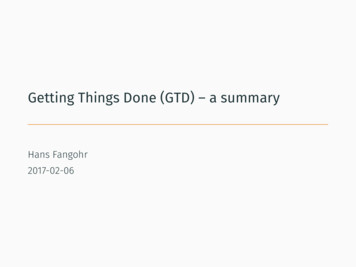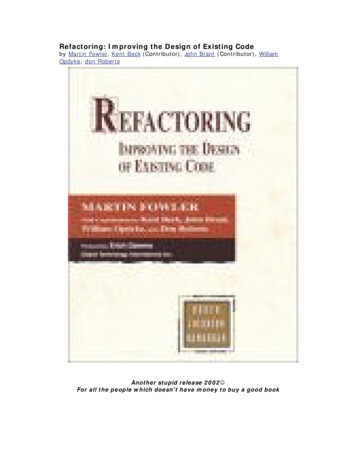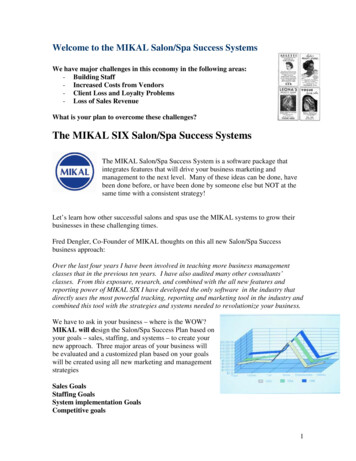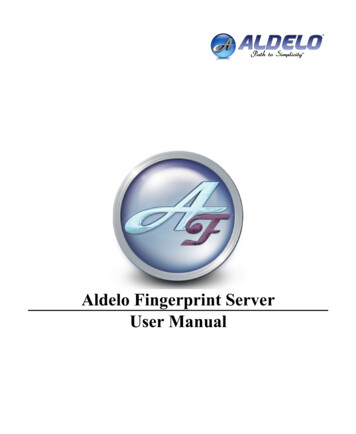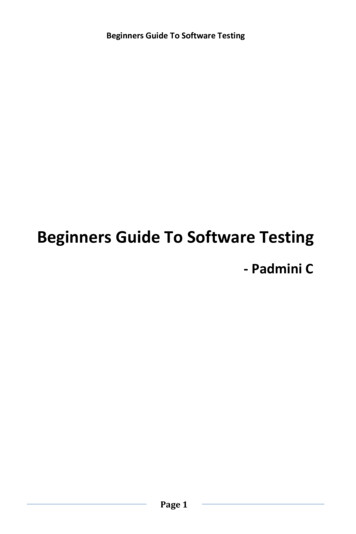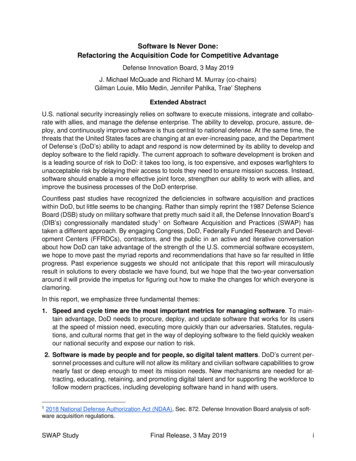
Transcription
Software Is Never Done:Refactoring the Acquisition Code for Competitive AdvantageDefense Innovation Board, 3 May 2019J. Michael McQuade and Richard M. Murray (co-chairs)Gilman Louie, Milo Medin, Jennifer Pahlka, Trae' StephensExtended AbstractU.S. national security increasingly relies on software to execute missions, integrate and collaborate with allies, and manage the defense enterprise. The ability to develop, procure, assure, deploy, and continuously improve software is thus central to national defense. At the same time, thethreats that the United States faces are changing at an ever-increasing pace, and the Departmentof Defense’s (DoD’s) ability to adapt and respond is now determined by its ability to develop anddeploy software to the field rapidly. The current approach to software development is broken andis a leading source of risk to DoD: it takes too long, is too expensive, and exposes warfighters tounacceptable risk by delaying their access to tools they need to ensure mission success. Instead,software should enable a more effective joint force, strengthen our ability to work with allies, andimprove the business processes of the DoD enterprise.Countless past studies have recognized the deficiencies in software acquisition and practiceswithin DoD, but little seems to be changing. Rather than simply reprint the 1987 Defense ScienceBoard (DSB) study on military software that pretty much said it all, the Defense Innovation Board’s(DIB’s) congressionally mandated study 1 on Software Acquisition and Practices (SWAP) hastaken a different approach. By engaging Congress, DoD, Federally Funded Research and Development Centers (FFRDCs), contractors, and the public in an active and iterative conversationabout how DoD can take advantage of the strength of the U.S. commercial software ecosystem,we hope to move past the myriad reports and recommendations that have so far resulted in littleprogress. Past experience suggests we should not anticipate that this report will miraculouslyresult in solutions to every obstacle we have found, but we hope that the two-year conversationaround it will provide the impetus for figuring out how to make the changes for which everyone isclamoring.In this report, we emphasize three fundamental themes:1. Speed and cycle time are the most important metrics for managing software. To maintain advantage, DoD needs to procure, deploy, and update software that works for its usersat the speed of mission need, executing more quickly than our adversaries. Statutes, regulations, and cultural norms that get in the way of deploying software to the field quickly weakenour national security and expose our nation to risk.2. Software is made by people and for people, so digital talent matters. DoD’s current personnel processes and culture will not allow its military and civilian software capabilities to grownearly fast or deep enough to meet its mission needs. New mechanisms are needed for attracting, educating, retaining, and promoting digital talent and for supporting the workforce tofollow modern practices, including developing software hand in hand with users.12018 National Defense Authorization Act (NDAA), Sec. 872. Defense Innovation Board analysis of software acquisition regulations.SWAP StudyFinal Release, 3 May 2019i
3. Software is different than hardware (and not all software is the same). Hardware can bedeveloped, procured, and maintained in a linear fashion. Software is an enduring capabilitythat must be supported and continuously improved throughout its life cycle. DoD must streamline its acquisition process and transform its culture to enable effective delivery and oversightof multiple types of software-enabled systems, at scale, and at the speed of relevance.To take advantage of the power of software, we advocate four main lines of effort:A. Congress and DoD should refactor statutes, regulations, and processes for software,enabling rapid deployment and continuous improvement of software to the field and providingincreased insight to reduce the risk of slow, costly, and overgrown programs.B. The Office of the Secretary of Defense (OSD) and the Services should create and maintain cross-program/cross-Service digital infrastructure that enables rapid deployment,scaling, testing, and optimization of software as an enduring capability; manage them usingmodern development methods; and eliminate the existing hardware-centric regulations andother barriers.C. The Services and OSD will need to create new paths for digital talent (especially internaltalent) by establishing software development as a high-visibility, high-priority career track andincreasing the level of understanding of modern software within the acquisition workforce.D. DoD and industry must change the practice of how software is procured and developedby adopting modern software development approaches, prioritizing speed as the critical metric, ensuring cybersecurity is an integrated element of the entire software life cycle, and purchasing existing commercial software whenever possible.Report structure. The main report provides an assessment of the current and desired states forsoftware acquisition and practices, as well as a review of previous reports and an assessment ofwhy little has changed in the way DoD acquires software, with emphasis on three fundamentalthemes. The report’s recommendations are broken into four linesof effort, with a set of primary recommendations provided for each(bold), along with additional recommendations that can providefurther improvements. Each recommendation is accompanied bya draft implementation plan andpotential legislative language.SWAP StudyFinal Release, 3 May 2019ii
Table of ContentsChapter 0. README (Executive Summary)Recommendations Cheat SheetvxivChapter 1. Who Cares: Why Does Software Matter for DoD? Where Are We Coming From, Where Are We Going? Weapons and Software and Systems, Oh My! A Taxonomy for DoD What Kind of Software Practices Will We Have to Enable? What Challenges Do We Face (and Consequences of Inaction)?1Chapter 2. What Does It Look Like to Do Software Right? How It Works in Industry (and Can/Should Work in DoD): DevSecOps Empowering the Workforce: Building Talent Inside and Out Getting It Right: Better Oversight AND Superior National Security Eye on the Prize: What Is the R&D Strategy for Our Investment?918Chapter 3. Been There, Done Said That: Why Hasn’t This Already Happened? 37 Years of Prior Reports on DoD Software Breaking the Spell: Why Nothing Happened Before, but Why This Time Could Be Different Consequences of Inaction: Increasing Our Attack Surface/Shifting Risk to the WarfighterChapter 4. How Do We Get There from Here: Three Paths for Moving Forward29 Path 1: Make the Best of What We’ve Got Path 2: Tune the Defense Acquisition System to Optimize for Software Path 3: A New Acquisition Pathway/Appropriations Category to Force Change in the MiddleChapter 5. What Would the DIB Do: Our Recommendations for Congress and DoD The Ten Most Important Things To Do (Starting Now!) The Next Most Important Things to Tackle Monitoring and Oversight of the Implementation Plan Kicking the Can Down the Road: Things That We Could Not Figure Out How to Fix35Acknowledgments48Vignettes Implementing Continuous Delivery: The JIDO Approach F22: DevOps on a Hardware Platform Making It Hard to Help: A Self-Denial of Service Attack for the SWAP Study DDS: Fighting the Hiring Process Instead of Our Adversaries Kessel Run: The Future of Defense Acquisitions Is #AgileAF JMS: Seven Signs Your Software (Program) Is in Trouble50SWAP StudyFinal Release, 3 May 2019iii
Supporting InformationAppendix A. Draft Implementation Plan Background, Desired State, Congressional Role List of Actions, Related Recommendations, Previous RecommendationsS1Appendix B. Legislative Opportunities in Response to 2016 NDAA Section 805S58Appendix C. An Alternative to P- and R-Forms: How to Track Software ProgramsS64Appendix D. Frequently Asked Questions (FAQs)S71Appendix E. DIB Guides for Software Ten Commandments of Software Metrics for Software Development Do’s and Don’ts for Software Detecting Agile BS Is Your Development Environment Holding You Back? Is Your Compute Environment Holding You Back? Site Visit Observations and Recommendations How to Justify Your Budget When Doing DevSecOpsS75Appendix F. SWAP Working Group Reports (DIB remix) Acquisition StrategyAppropriationsContractsData and MetricsInfrastructure S130RequirementsSecurity Certification/AccreditationSustainment and ModernizationTest and EvaluationWorkforceAppendix G. Analysis the Old-Fashioned Way: A Look at Past DoD SW Projects Software Development Project Analyses Software Development Data AnalysesS162Appendix H. Replacing Augmenting CAPE with AI/ML Software Life-Cycle Prediction Model Software Development Forecasting Model Investigation of Opportunities for Analytic InterventionS178Appendix I. Acronyms and Glossary of TermsS190Appendix J. Study InformationS198 SWAP Study Membership/SWAP Working Group MembershipPrograms and Companies Visited/Department MeetingsCharge from CongressTerms of ReferenceSWAP StudyFinal Release, 3 May 2019iv
Chapter 0. README (Executive Summary)In 2011, Marc Andreessen claimed in an op-ed for The Wall Street Journal that “Software Is Eatingthe World.” 2 He argued that every industry (not just those considered to be “information technology”) would be transformed by software—bytes rather than atoms. Eight years later, it is clear hewas right.This transformation is happening in defense, and we are not prepared for it. Software is levelingthe playing field with our rivals, eroding the advantages we have spent many decades accruing.Software is the focal point of many important advances in national security technology, includingdata analytics, artificial intelligence (AI), machine learning (ML), and autonomy. Software is ubiquitous. It is part of everything the Department of Defense (DoD) does, from logistics to management to weapon systems. U.S. national security is critically dependent on the capabilities of DoD’ssoftware.DoD must be able to develop, procure, assure, deploy, and continuously improve software fasterthan our adversaries. Unfortunately, DoD still treats software much like hardware, and often misunderstands the relationship between speed and security. As a result, a large amount of DoD’ssoftware takes too long, costs too much, and is too brittle to be competitive in the long run. If DoDdoes not take steps to modernize its software acquisition and development practices, we will nolonger have the best military in the world, no matter how much we invest or how talented anddedicated our armed forces may be.The good news is that there are organizations within DoD that have already acknowledged therisks of falling further behind in software and are leveraging more modern acquisition and development practices with notable success. The Defense Digital Service (DDS), the Defense Innovation Unit (DIU), the Joint Improvised-Threat Defeat Organization (JIDO), and the Air Force’s Kessel Run are examples that demonstrate that DoD has the ability to ship world-class software. Thechallenge remains doing this at scale.DoD needs to build on these foundations to create an ecosystem and standard operating procedures that enable the practices of great software without requiring employees to “hack the system.” To do that, we must address the prioritization, planning, and acquisition processes andpolicies that create the worst bottlenecks for deploying capability to the field at the speed of relevance. Further, we must address all the practices that not only put the U.S. Armed Forces at riskand reduce the efficiency of DoD’s operations, but also drive away the very people who are mostneeded to develop this critical capability.Our adversaries are already doing this. China actively leverages its private industry to developnational security software (particularly in AI), recruits top students under the age of 18 to work on“intelligent weapons design,” 3 and poaches U.S. software talent directly from the United States.In Russia, Vladimir Putin has told students, that “artificial intelligence is the future, not only forRussia, but for all humankind. Whoever becomes the leader in this sphere will become the ruler2Marc Andreessen, “Why Software Is Eating the World,” The Wall Street Journal, August 20, 2011, 1.Stephen Chen, “China’s Brightest Children Are Being Recruited to Develop AI ‘Killer Bots,’” South ChinaMorning Post, November 8, 2018.3SWAP StudyFinal Release, 3 May 2019v
of the world.” 4 We can and must outcompete with software and the people who make it, not onlyto maintain U.S. military superiority but also to ensure that the power that software represents isused in accordance with American values.What this report is about. This report summarizes the assessment of the Defense InnovationBoard’s (DIB’s) Software Acquisition and Practices (SWAP) study. Congress charged 5 the DIB torecommend changes to statutes, regulations, processes, and culture to enable the better use ofsoftware in DoD. We took an iterative approach, mirroring the way modern software is successfully done, releasing a sequence of concept papers describing our preliminary observations andinsights. (The latest versions of these are included in Appendix E.) We used those papers toencourage dialogue with a wide variety of individuals and groups to gain insights into the currentbarriers to implementing modern software effectively and efficiently. This document captures keyinsights from these discussions in an easy-to-read format that highlights the elements that weconsider critical for DoD’s success and serves as a starting point for continued discussions required to implement the changes that we recommend here.This report is organized as follows: Extended Abstract: A two-page summary of the key takeaways from the report. README (this document): A more detailed executive summary of the report. (A README fileis used by the open source software community to provide essential information about a software package.) If your boss heard about the report or read the extended abstract, thought itwas intriguing, and asked you to read the entire report and provide a short summary, cut andpaste this chapter into your reply and you should be good to go. Recommendations Cheat Sheet: A list of the main lines of effort and primary recommendations, so you can pretty much stop at that point—or better yet, stop after suggesting to yourboss they adopt them all. Chapters 1–4: Short descriptions of key areas and topics. If you attach the extended abstractto any one of these as a preface, it should be comprehensible. Chapter 5: A more detailed description of the recommendations and our rationale. Supporting Information: To ensure that the executive summary and the main body of thereport satisfy the takeoff test 6 and the staple test, 7 we put most of the additional informationgenerated during the study into a set of appendices. These provide a wealth of examples and4James Vincent, “Putin Says the Nation that Leads in AI ‘will be the ruler of the world,’” The Verge, September 4, 2017: ai-putin-rule-the-world.5Section 872 of the FY18 NDAA directed the Secretary of Defense to "direct the Defense InnovationBoard to undertake a study on streamlining software development and acquisition regulations." The DIBSWAP members were charged to “review the acquisitions regulations applicable to, and organizationalstructures within, the Department of Defense ; review ongoing software development and acquisitionprograms ; produce specific and detailed recommendations ; and produce such additional recommendations for legislation.” See Section 872 of the FY18 NDAA at publ91.pdf or Appendix J of this report.6Reports should be short enough to read during takeoff, before the movies start and drinks are served.7Any report that is going to be read should be thin enough to be stapled with a regular office stapler.SWAP StudyFinal Release, 3 May 2019vi
evidence, but we took care to put our essential arguments up front for less wonky types. Somehighlights: Draft implementation (Appendix A): For each recommendation, a summary of the background, desired state, stakeholders, role of Congress, and actions to be taken. Legislative language (Appendix B): In response to 2016 NDAA Section 805, templatelegislative language for a new acquisition pathway and appropriation category for software, aligned with our recommendations. An alternative to P-Forms and R-Forms (Appendix C): A different mechanism for budgetsubmissions for software programs. FAQs (frequently asked questions, Appendix D): A list of the most common questions thatwe get about the study and our attempt to answer them. (Question 1: Hasn’t all of thisbeen recommended before? A: Yes ).Note: If you are reading any portion of the report in paper form, a navigable version is availableat http://innovation.defense.gov/software.Overarching themes. The rise of electronics, computing, and networking has forever transformed the way we live: software is a part of almost everything with which we interact in our dailylives, either directly through embedded computation in the objects around us or indirectly throughthe use of information technology through all stages of design, development, deployment, andoperations. Our military advantage, coordination with allies and partners, operational security,and many other aspects of DoD activities are all contingent upon our software edge, and any lackthereof presents serious consequences. Software drives our military advantage: what makesweapon systems sophisticated is the software, not (just) the hardware.Commercial trends show what is possible with software, from the use of open source tools to agiledevelopment techniques to global-scale cloud computing. Because of these changes, softwarecan be developed, deployed, and updated much more quickly, which means systems need to bein place to support this speed. But modern software development requires a new set of skills andmethodologies (e.g., generalist software engineers, specialized product management, DevOpsand DevSecOps, agile development). Hence, the policies and systems surrounding software mustbe transformed to support software, not Cold-War-era weapon manufacturing.The incoming generation of military and civilian personnel began life digitally plugged-in, with aninnate reliance on software-based systems. They will demand new concepts of operations, tactics, and strategies to maintain the edge they need. If DoD can refactor its acquisition processesand transform its culture and personnel policies before it is too late, this software-savvy generationcan still set the Department on the right course.As we studied the methods that the private sector has used to enable software to transform itsoperations and considered how to best apply those practices to the defense enterprise, threeoverarching themes emerged as the basis for our recommendations:1. Speed and cycle time are the most important metrics for software.SWAP StudyFinal Release, 3 May 2019vii
2. Software is made by people and for people, so digital talent matters.3. Software is different than hardware (and not all software is the same).Speed and cycle time are the most important metrics for software. Most DoD software projectsare currently managed using “waterfall” development processes, which involve spending yearson developing requirements, taking bids and selecting contractors, and then executing programsthat must meet the listed requirements before they are “done.” This results in software that takesso long to reach the field that it is often not well matched to the current needs of the user or tacticsof our adversaries, which have often changed significantly while the software was being written,tested, and accepted. Being able to develop and deploy faster than our adversaries means thatwe can provide more advanced capabilities, respond to our adversaries’ moves, and be moreresponsive to our end users. Faster reduces risk because it demands focus on the critical functionality rather than over-specification or bloated requirements. It also means we can identify trouble earlier and take faster corrective action, which reduces cost, time, and risk. Faster leads toincreased reliability: the more quickly software/code is in the hands of users, the more quicklyfeedback can focus on efforts to deploy greater capability. Faster gives us a tactical advantageon the battlefield by allowing operation and response inside our adversaries’ observe–orient–decide–act (OODA) loops. Faster is more secure. Faster is possible.Software is made by people and for people, so digital talent matters. Current DoD human resourcepolicies are not conducive to attracting, retaining, and promoting digital talent. Talented softwaredevelopers and acquisition personnel with software experience are often put in jobs that do notallow them to make use of those talents, particularly in the military where rotating job assignmentsmay not recognize and reward the importance of software development experience. As SteveJobs observed, 8 one of the major differences between hardware and software is that for hardwarethe “dynamic range” (ratio between the best in class and average performance) is, at most, 2:1.But, the difference between the best software developer and an average software developer canbe 50:1, or even 100:1, and putting great developers on a team with other great developers amplifies this effect. Today, in DoD and the industrial base that supports it, the people with the necessary skills exist, but instead of taking advantage of their skills we put them in environmentswhere it is difficult for them to be effective. DoD does not take advantage of already existingmilitary and civilian personnel expertise by offering pay bonuses, career paths that provide theability to stay in their specialization, or access to early promotions. Skilled software engineers andthe related specialties that are part of the overall software ecosystem need to be treated as aspecial force; the United States must harness their talent for the great benefits that it can provide.Software is different than hardware (and not all software is the same). Over the years, Congressand DoD have established a sophisticated set of statutes, regulations, and instructions that govern the development, procurement, and sustainment of defense systems. This process evolvedin the context of the Cold War, where major powers designed and built aircraft carriers, nuclearweapons, fighter jets, and submarines that were extremely expensive, lasted a very long time,and required tremendous access to capital and natural resources. Software, on the other hand,8Steve Jobs, “Steve Jobs: The Lost Interview,” interview by Robert X. Cringely for the 1995 PBS documentary, Triumph of the Nerds, released to limited theaters in 2012, video.SWAP StudyFinal Release, 3 May 2019viii
is something that can be mastered by a ragtag bunch of teenagers with very little money—andcan be used to quickly destabilize world powers. Currently most parts of DoD develop, procure,and manage software like hardware, assuming that it is developed based on a fixed set of specifications, procured after it has been shown to comply with those specifications, “maintained” byblock upgrades, and upgraded by replaying this entire procurement process linearly. But softwaredevelopment is fundamentally different than hardware development, and software should be developed, deployed, and continuously improved using much different cycle times, support infrastructure, and maintenance strategies. Testing and validation of software is also much differentthan for hardware, both in terms of the ability to automate but also in the potential vulnerabilitiesfound in software that is not kept up to date. Software is never “done” and must be managed asan enduring capability that is treated differently than hardware.Main lines of effort. DoD’s current approach to software is a major driver of cost and scheduleoverruns for Major Defense Acquisition Programs (MDAPs). Congress and DoD need to cometogether to fix the acquisition system for software because it is a primary source of its acquisitionheadaches.Bringing about the type of change that is required to give DoD the software capabilities it needsis going to take a significant amount of work. While it is possible to use the current acquisitionsystem and DoD processes to develop, procure, assure, deploy, and continuously improve DoDsoftware, the statutes, regulations, processes, and culture are debilitating. The current approachto acquisition was defined in a different era, for different purposes, and only works for softwareprojects through enormous effort and creativity. Congress, the Office of the Secretary of Defense(OSD), the Armed Services, defense contractors, and the myriad government and industry organizations involved in getting software out the door need to make major changes (together).To better organize our specific recommendations, we identified broad lines of effort that bringtogether different parts of the defense ecosystem as stakeholders. Here are the four main linesof effort that we recommend they undertake:A. (Congress and DoD) Refactor statutes, regulations, and processes for software, enabling rapid deployment and continuous improvement of software to the field and providingincreased insight to reduce the risk of slow, costly, and overgrown programs. The management and oversight of software development and acquisition must focus on different measuresand adopt a quicker cadence.B. (OSD and the Services) Create and maintain cross-program/cross-Service digital infrastructure that enables rapid deployment, scaling, testing, and optimization of software as anenduring capability; manage it using modern development methods; and eliminate the existinghardware-centric regulations and other barriers.C. (The Services and OSD) Create new paths for digital talent (especially internal talent)by establishing software development as a high-visibility, high-priority career track—with specialized recruiting, education, promotion, organization, incentives, and salary—and increasingthe level of understanding of modern software within the acquisition workforce.SWAP StudyFinal Release, 3 May 2019ix
D. (DoD and industry) Change the practice of how software is procured and developed byadopting modern software development approaches, prioritizing speed as the critical metric,ensuring cyber protection is an integrated element of the entire software life cycle, and purchasing existing commercial software whenever possible.None of these can be done by a single organization within the government. They will require abunch of hard-working, well-meaning people to work together to craft a set of statutes, regulations,processes, and (most importantly) a culture that recognizes the importance of software, the needfor speed and agility (theme 1), the critical role that smart people have to play in the process(theme 2), and the impact of inefficiencies of the current approach (theme 3). In many ways thismission is as challenging as any combat mission: while participants’ lives may not be directly atrisk in defining, implementing, and communicating the needed changes to policy and culture, thelives of those who defend our nation ultimately depend on DoD’s ability to redefine its approachto delivering combat-critical software to the field.Refactor statutes, regulations, and processes, streamlined for software. Congress has createdmany workarounds to allow DoD to be agile in its development of new weapon systems, and DoDhas used many of these to good effect. But the default statutes, regulations, and processes thatare used for software too often rely on the traditional hardware mentality (repeat: software is different than hardware), and those practices do not take advantage of what is possible (or, frankly,necessary, given the threat environment) with modern software. We think that a combination oftop-down and bottom-up pressure can break us out of the current state of affairs, and creating anew acquisition pathway that is tuned for software (of various types) will make a big difference.To this end, Congress and DoD should prototype and, after proving success, create mechanismsfor ideation, appropriation, and deployment of software-driven solutions that take advantage ofthe unique features of software (versus hardware) development (start small, iterate quickly, terminate early) and provide purpose-fit methods of oversight. As an important aside, note thatthroughout this study our recommendations adhere to this guiding axiom—start small, iteratequickly—the same axiom that characterizes the best of modern software innovation cycles (seethe “DIB Ten Commandments of Software” in Appendix E for more information about the DIB’sguiding principles for software acquisition).Create and maintain cross-program/cross-Service digital infrastructure. Current practice in DoDprograms is that each individual program builds its own infrastructure for computing, development,testing, and deployment, and there is little ability to build richer development and testing capabilities that are possible by making use of common infrastructure. Instead, we need to create, scale,and optimize an enterprise-level architecture and supporting infrastructure that enables creationand initial fielding of software within six months and continuous delivery of improvements on athree-month cycle. This “digital infrastructure,” common in commercial IT, is critical to enable rapiddeployment at the speed (and scale) of relevance. In order to implement this recommendation,Congress and DoD leadership must f
May 01, 2019 · Defense Innovation Board, 3 May 2019 . J. Michael McQuade and Richard M. Murray (co-chairs) . threats that the United States faces are changing at an ever -increasing pace, and the Department of Defense’s (DoD’s) ability to adapt and respond is now determined by its ability to develop and . T

